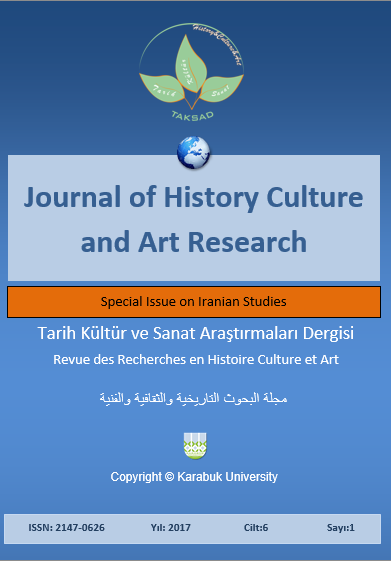Heroic Legends and Epic
DOI:
https://doi.org/10.7596/taksad.v6i1.764Keywords:
Story, Narration, Epic, Romance, Character.Abstract
In the current study, Romance, as a literary style that has some similar and dissimilar features to epic story, has been compared and contrasted to epic. Some common qualities of romance and epic are: extraordinary plot of events, fictitious story, long story, being preceded by oral narration, express the events that happened in distant past, supernatural cases in story, supporting hero and opposing anti-hero, superstitious and witchery in both of them, the presence of bravery, knighthood and forecasting elements in both. Both stories are based on contrasts or the world is viewed as opposite poles, and characters of both are considered to be “flat”.
Epic and romance have dissimilarities. Romance stories are oriented toward love and passion besides the bravery. The top hero of epic is degraded in romance to a lower position. The bravery spirit in romance is reduced and there is a possibility of defeating romance’s hero. However, the hero of epic is undefeatable. The hero of epic pursues greater goals in relation to heroic deeds. The descriptions of the battle are more precise and poetic in epic while romance is incapable of providing exact descriptions of wars. Epic is a source of glory and pride. However, romance is folksier. Therefore, this study investigates the commonalities and the differences between epic and romance.
References
Afshari, Iraj & Afshari, Mehran (2007). Story of Hosein Kord Shabestari. Second edition, Tehran: Cheshme Publication.
Alkateb Alarjani, Faramarz ben Khodadad ben Abdollah. (1983). Samak Ayyar with Introduction and Edition by Parviz Natel Khanlari. Tehran: Agah Publication.
Anousheh, Hasan (1997). Farhangname Adabi Farsi, 2nd volume. Tehran: Press Institute.
Barakat, Abdolkafi (2008). Eskandarnammeh (the first collecter). With effort of iraj afshar. Tehran: Cheshme Publication.
Beer, Gillian (2004). The Romance, translation of Soudabe Daghighi, second edition, Tehran. Markaz Press.
Beighami, Mohamad (2009). Firouzshahname, Iraj Afshar & Mehran afshari. Tehran: Cheshme Publication.
Ferdosi, Abolghasem (1994). Shahname, edited by R. Aliyof, A. Berles, M. Osmanof, with attempt of said hamidyan. Tehran: Ghatre Publication.
Frye, Northrop (2005). Sahifehaye Zamini, translated by Houshang Rahnama. Tehran: Hermes.
Gorgani, Fakhrildin Asad (2002). Veis & Ramin, edited by Mohamad Roshan, second edition, Tehran: Sedaye Moaser Publication.
Hakim, Manouchehrkhan (2007). Eskandarnameh. With effort of Alireza Zekavati Gharagouzlou. Tehran: Sokhan Publication.
Hakim, Manoucherkhan (2004). Eskandar & Ayyaran (summarize of Eskandarnameh narrated by Manoucherkhan hakim). Edited by Alireza Zekavati Gharagouzlou. Tehran: Nashr Ney.
Homer (1998). Iliad, translated by Mirjalal Oldin Kazazi. Tehran: Markaz Publication.
Jafari (Ghanavati), Mohamad (2004). “Falak Nazname va Adabyat Shafahi”, Ketab Mah & Adabyat & Falsafe, number 80 & 81. Khordad & Tir, pp.118-125.
Kermani, Khajou (1991). Homay and Homayoun. Edited by Kamaleldin Eini. Tehran: Cultural Research Institution.
Khaleghi Motlagh, Jalal (1993). Gol Ranjhaye Kohan. Tehran: Markaz Publication.
Khaleghi Motlagh, Jalal (2007). Hemase: Padideshenasi Tatbighi Sher Pahlavani, second edition, Tehran: Islamic Encyclopedia.
Mihandoust, Mohsen (2001). General Research of Vulgar Culture. Tehran: Tous Publication.
Naghib Almamalek, Mohamad Ali (1977). Amirarsalan, edited by Mohamad Jafar Mahjoub, second edition. Tehran: Corporation of Pocket Books.
Safa, Zabihallah (1984). Hemase Soraei dar Iran, fourth edition. Tehran: Amir Kabir.
Shamisa, Sirous (1994). Anva Adabi, second edition. Tehran: Ferdosi Publication.
Shoar, Jafar (1968). Gheseye Hamze (Hamzenama). Tehran: Tehran University Publication.
Shoar, Jafar (ed.) (1983). Story of Amirmomenin Hamze, (69 stories). Second edition. Tehran: Ketab Forouzan Publication.
Tartousi, Aboutaher (2001). Aboumoslemname, with Effort of Hosein Esmaeili. Tehran: Moein and Ghatre Publication.
Zarafa, Michel (2007). Jameshenasi Adabyat Dastani, translated by Nasrin Parvini. Tehran: Sokhan Publication.
Downloads
Published
How to Cite
Issue
Section
License
All papers licensed under Creative Commons 4.0 CC-BY.- Share — copy and redistribute the material in any medium or format
- Adapt — remix, transform, and build upon the material for any purpose, even commercially.
Under the following terms:
Attribution — You must give appropriate credit, provide a link to the license, and indicate if changes were made. You may do so in any reasonable manner, but not in any way that suggests the licensor endorses you or your use.
- No additional restrictions — You may not apply legal terms or technological measures that legally restrict others from doing anything the license permits.







